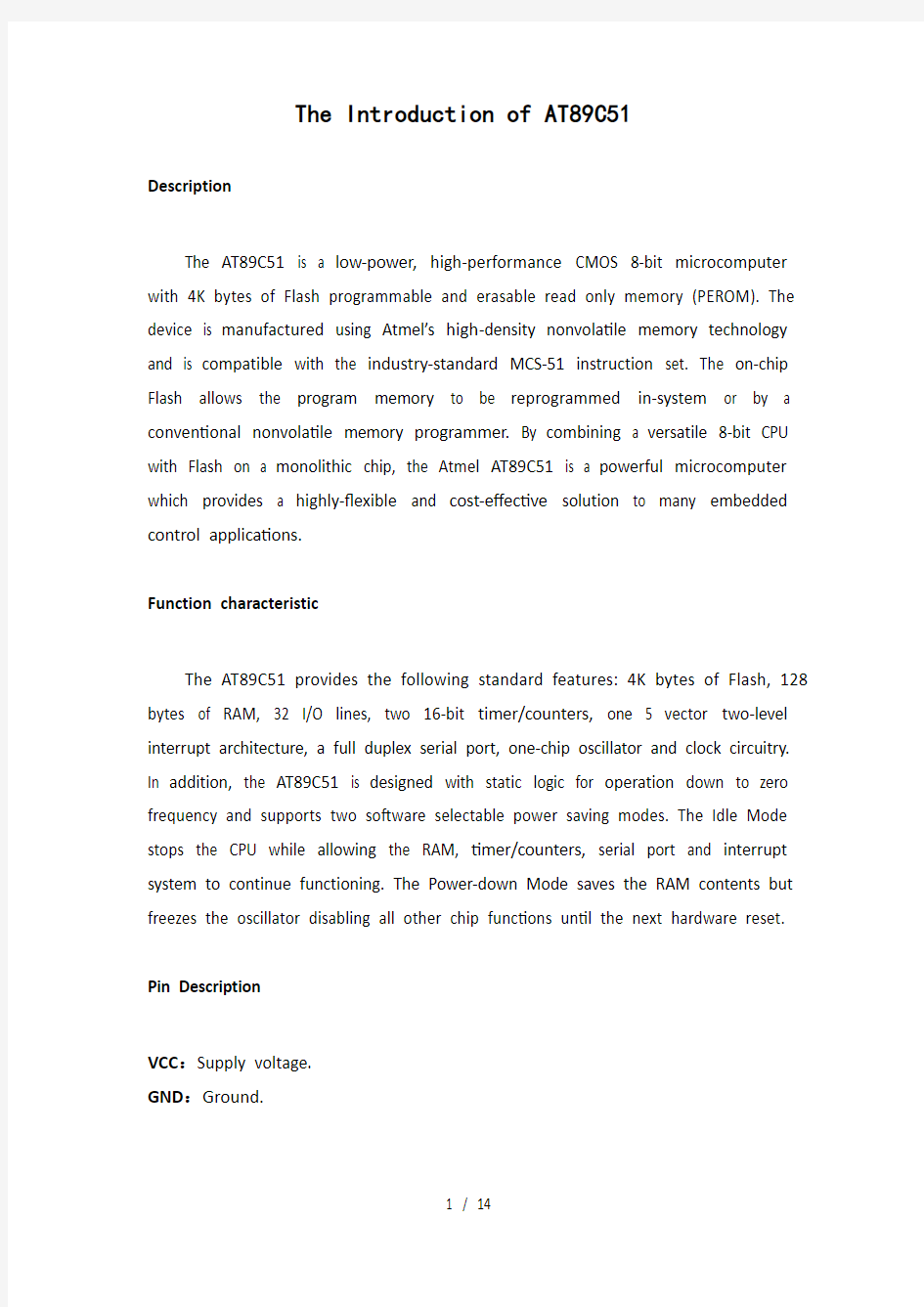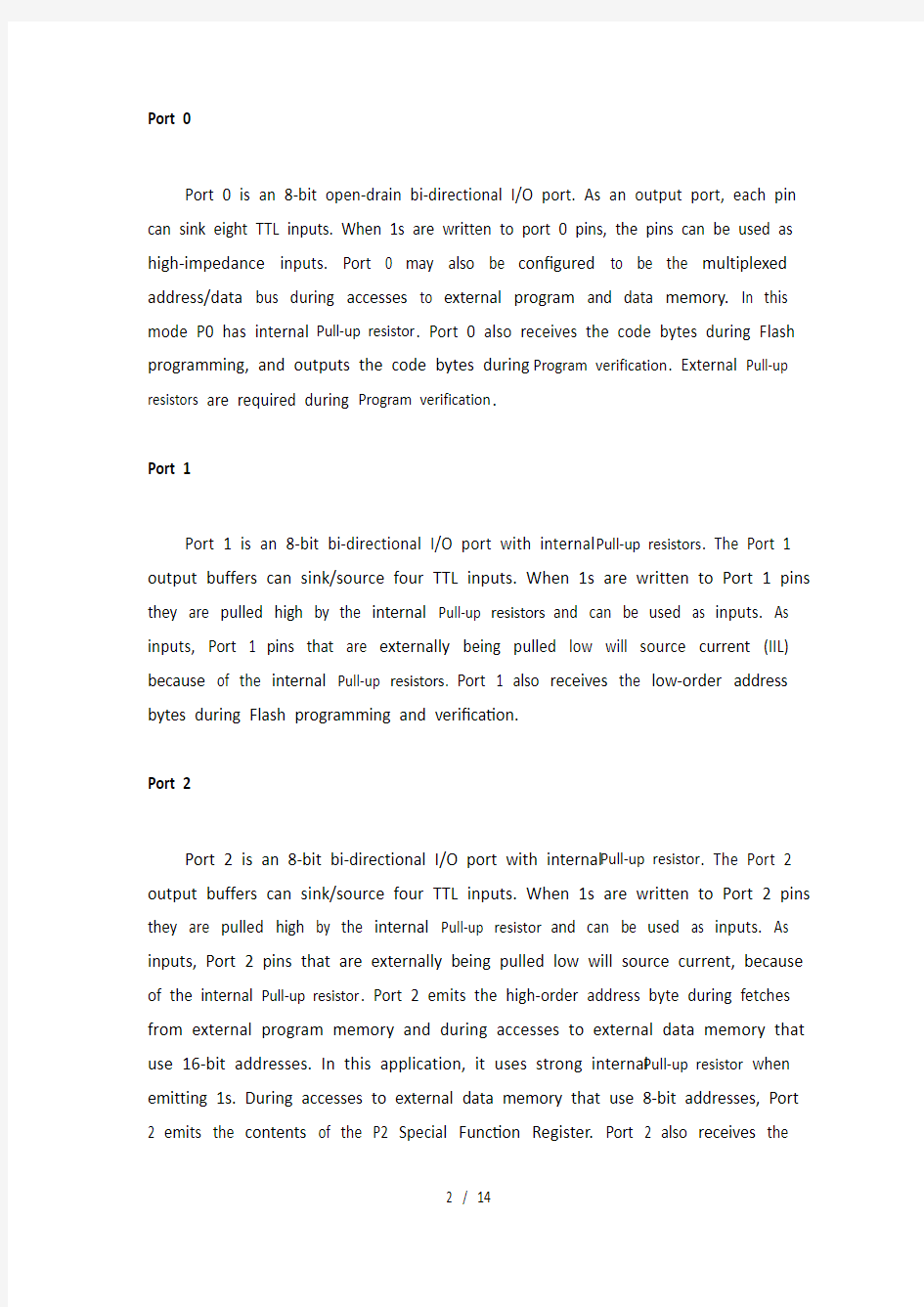单片机外文文献


The Introduction of AT89C51
Description
The AT89C51 is a low-power, high-performance CMOS 8-bit microcomputer with 4K bytes of Flash programmable and erasable read only memory (PEROM). The device is manufactured using Atmel’s high-density nonvolatile memory technology and is compatible with the industry-standard MCS-51 instruction set. The on-chip Flash allows the program memory to be reprogrammed in-system or by a conventional nonvolatile memory programmer. By combining a versatile 8-bit CPU with Flash on a monolithic chip, the Atmel AT89C51 is a powerful microcomputer which provides a highly-flexible and cost-effective solution to many embedded control applications.
Function characteristic
The AT89C51 provides the following standard features: 4K bytes of Flash, 128 bytes of RAM, 32 I/O lines, two 16-bit timer/counters, one 5 vector two-level interrupt architecture, a full duplex serial port, one-chip oscillator and clock circuitry. In addition, the AT89C51 is designed with static logic for operation down to zero frequency and supports two software selectable power saving modes. The Idle Mode stops the CPU while allowing the RAM, timer/counters, serial port and interrupt system to continue functioning. The Power-down Mode saves the RAM contents but freezes the oscillator disabling all other chip functions until the next hardware reset.
Pin Description
VCC:Supply voltage.
GND:Ground.
Port 0
Port 0 is an 8-bit open-drain bi-directional I/O port. As an output port, each pin can sink eight TTL inputs. When 1s are written to port 0 pins, the pins can be used as high-impedance inputs. Port 0 may also be configured to be the multiplexed address/data bus during accesses to external program and data memory. In this mode P0 has internal Pull-up resistor. Port 0 also receives the code bytes during Flash programming, and outputs the code bytes during Program verification. External Pull-up resistors are required during Program verification.
Port 1
Port 1 is an 8-bit bi-directional I/O port with internal Pull-up resistors. The Port 1 output buffers can sink/source four TTL inputs. When 1s are written to Port 1 pins they are pulled high by the internal Pull-up resistors and can be used as inputs. As inputs, Port 1 pins that are externally being pulled low will source current (IIL) because of the internal Pull-up resistors. Port 1 also receives the low-order address bytes during Flash programming and verification.
Port 2
Port 2 is an 8-bit bi-directional I/O port with internal Pull-up resistor. The Port 2 output buffers can sink/source four TTL inputs. When 1s are written to Port 2 pins they are pulled high by the internal Pull-up resistor and can be used as inputs. As inputs, Port 2 pins that are externally being pulled low will source current, because of the internal Pull-up resistor. Port 2 emits the high-order address byte during fetches from external program memory and during accesses to external data memory that use 16-bit addresses. In this application, it uses strong internal Pull-up resistor when emitting 1s. During accesses to external data memory that use 8-bit addresses, Port 2 emits the contents of the P2 Special Function Register. Port 2 also receives the
high-order address bits and some control signals during Flash programming and verification.
Port 3
Port 3 is an 8-bit bi-directional I/O port with internal Pull-up resistor. The Port 3 output buffers can sink/source four TTL inputs. When 1s are written to Port 3 pins they are pulled high by the internal Pull-up resistor and can be used as inputs. As inputs, Port 3 pins that are externally being pulled low will source current (IIL) because of the Pull-up resistor. Port 3 also serves the functions of various special features of the AT89C51 as listed below:
Port 3 also receives some control signals for Flash programming and verification.
RST
Reset input. A high on this pin for two machine cycles while the oscillator is running resets the device.
ALE/PROG
Address Latch Enable output pulse for latching the low byte of the address
during accesses to external memory. This pin is also the program pulse input (PROG) during Flash programming. In normal operation ALE is emitted at a constant rate of 1/6 the oscillator frequency, and may be used for external timing or clocking purposes. Note, however, that one ALE pulse is skipped during each access to external Data Memory.
If desired, ALE operation can be disabled by setting bit 0 of SFR location 8EH. With the bit set, ALE is active only during a MOVX or MOVC instruction. Otherwise, the pin is weakly pulled high. Setting the ALE-disable bit has no effect if the microcontroller is in external execution mode.
PSEN
Program Store Enable is the read strobe to external program memory. When the AT89C51 is executing code from external program memory, PSEN is activated twice each machine cycle, except that two PSEN activations are skipped during each access to external data memory.
EA/VPP
External Access Enable. EA must be strapped to GND in order to enable the device to fetch code from external program memory locations starting at 0000H up to FFFFH. Note, however, that if lock bit 1 is programmed, EA will be internally latched on reset. EA should be strapped to VCC for internal program executions. This pin also receives the 12-volt programming enable voltage (VPP) during Flash programming, for parts that require12-volt VPP.
XTAL1
Input to the inverting oscillator amplifier and input to the internal clock operating circuit.
XTAL2
Output from the inverting oscillator amplifier.
Oscillator Characteristics
XTAL1 and XTAL2 are the input and output, respectively, of an inverting amplifier which can be configured for use as an on-chip oscillator, as shown in Figure 1.Either a quartz crystal or ceramic resonator may be used. To drive the device from an external clock source, XTAL2 should be left unconnected while XTAL1 is driven as shown in Figure 2.There are no requirements on the duty cycle of the external clock signal, since the input to the internal clocking circuitry is through a divide-by-two flip-flop, but minimum and maximum voltage high and low time specifications must be observed.
Figure 1. Oscillator Connections Figure 2. External Clock Drive Configuration
Idle Mode
In idle mode, the CPU puts itself to sleep while all the on chip peripherals remain active. The mode is invoked by software. The content of the on-chip RAM and all the special functions registers remain unchanged during this mode. The idle mode can be terminated by any enabled interrupt or by a hardware reset. It should be noted that when idle is terminated by a hard ware reset, the device normally resumes program execution, from where it left off, up to two machine cycles before the internal reset algorithm takes control. On-chip hardware inhibits access to internal RAM in this event, but access to the port pins is not inhibited. To eliminate the possibility of an unexpected write to a port pin when Idle is terminated by reset, the instruction following the one that invokes Idle should not be one that writes to a port pin or to external memory.
Power-down Mode
In the power-down mode, the oscillator is stopped, and the instruction that invokes power-down is the last instruction executed. The on-chip RAM and Special Function Registers retain their values until the power-down mode is terminated. The only exit from power-down is a hardware reset. Reset redefines the SFRs but does not change the on-chip RAM. The reset should not be activated before VCC is restored to its normal operating level and must be held active long enough to allow the oscillator to restart and stabilize.
Program Memory Lock Bits
On the chip are three lock bits which can be left unprogrammed (U) or can be programmed (P) to obtain the additional features listed in the table below.
When lock bit 1 is programmed, the logic level at the EA pin is sampled and latched during reset. If the device is powered up without a reset, the latch initializes to a random value, and holds that value until reset is activated. It is necessary that the latched value of EA be in agreement with the current logic level at that pin in order for the device to function properly.
译文:
AT89C51的介绍
描述
AT89C51是一个低电压,高性能CMOS 8位单片机带有4K字节的可反复擦写的程序存储器(PENROM)。这种器件采用ATMEL公司的高密度、不容易丢失存储技术生产,并且能够与MCS-51系列的单片机兼容。片内含有8位中央处理器
和闪烁存储单元,有较强的功能的AT89C51单片机能够被应用到控制领域中。功能特性
AT89C51提供以下的功能标准:4K字节闪烁存储器,128字节随机存取数据存储器,32个I/O口,2个16位定时/计数器,1个5向量两级中断结构,1个串行通信口,片内震荡器和时钟电路。另外,AT89C51还可以进行0HZ的静态逻辑操作,并支持两种软件的节电模式。闲散方式停止中央处理器的工作,能够允许随机存取数据存储器、定时/计数器、串行通信口及中断系统继续工作。掉电方式保存随机存取数据存储器中的内容,但震荡器停止工作并禁止其它所有部件的工作直到下一个复位。
引脚描述
VCC:电源电压
GND:地
P0口
P0口是一组8位漏极开路双向I/O口,即地址/数据总线复用口。作为输出口时,每一个管脚都能够驱动8个TTL电路。当“1”被写入P0口时,每个管脚都能够作为高阻抗输入端。P0口还能够在访问外部数据存储器或程序存储器时,转换地址和数据总线复用,并在这时激活内部的上拉电阻。P0口在闪烁编程时,P0口接收指令,在程序校验时,输出指令,需要接电阻。
P1口
P1口一个带内部上拉电阻的8位双向I/O口,P1的输出缓冲级可驱动4个TTL电路。对端口写“1”,通过内部的电阻把端口拉到高电平,此时可作为输入口。因为内部有电阻,某个引脚被外部信号拉低时输出一个电流。闪烁编程时和程序校验时,P1口接收低8位地址。
P2口
P2口是一个内部带有上拉电阻的8位双向I/O口,P2的输出缓冲级可驱动4个TTL电路。对端口写“1”,通过内部的电阻把端口拉到高电平,此时,可作为输入口。因为内部有电阻,某个引脚被外部信号拉低时会输出一个电流。在访问外部程序存储器或16位地址的外部数据存储器时,P2口送出高8位地址数据。在访问8位地址的外部数据存储器时,P2口线上的内容在整个运行期间不变。闪烁编程或校验时,P2口接收高位地址和其它控制信号。
P3口
P3口是一组带有内部电阻的8位双向I/O口,P3口输出缓冲故可驱动4个TTL电路。对P3口写如“1”时,它们被内部电阻拉到高电平并可作为输入端时,被外部拉低的P3口将用电阻输出电流。
P3口除了作为一般的I/O口外,更重要的用途是它的第二功能,如下表所示:
P3口还接收一些用于闪烁存储器编程和程序校验的控制信号。
RST
复位输入。当震荡器工作时,RET引脚出现两个机器周期以上的高电平将使
单片机复位。
ALE/ PROG
当访问外部程序存储器或数据存储器时,ALE输出脉冲用于锁存地址的低8位字节。即使不访问外部存储器,ALE以时钟震荡频率的1/16输出固定的正脉冲信号,因此它可对输出时钟或用于定时目的。要注意的是:每当访问外部数据存储器时将跳过一个ALE脉冲时,闪烁存储器编程时,这个引脚还用于输入编程脉冲。如果必要,可对特殊寄存器区中的8EH单元的D0位置禁止ALE操作。这个位置后只有一条MOVX和MOVC指令ALE才会被应用。此外,这个引脚会微弱拉高,单片机执行外部程序时,应设置ALE无效。
PSEN
程序储存允许输出是外部程序存储器的读选通信号,当AT89C51由外部程序存储器读取指令时,每个机器周期两次PSEN 有效,即输出两个脉冲。在此期间,当访问外部数据存储器时,这两次有效的PSEN 信号不出现。
EA/VPP
外部访问允许。欲使中央处理器仅访问外部程序存储器,EA端必须保持低电平。需要注意的是:如果加密位LBI被编程,复位时内部会锁存EA端状态。如EA端为高电平,CPU则执行内部程序存储器中的指令。闪烁存储器编程时,该引脚加上+12V的编程允许电压VPP,当然这必须是该器件是使用12V编程电压VPP。
XTAL1:震荡器反相放大器及内部时钟发生器的输入端。
XTAL2:震荡器反相放大器的输出端。
